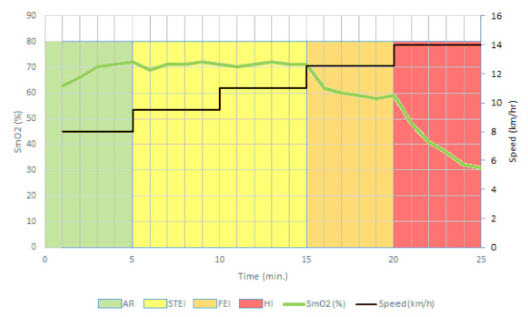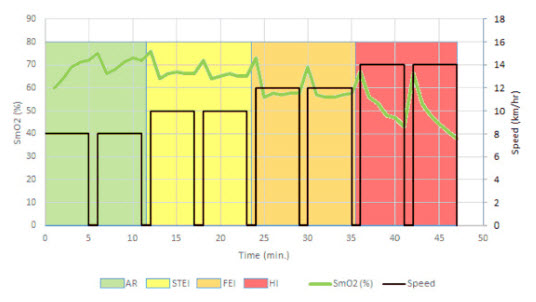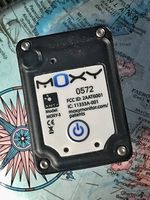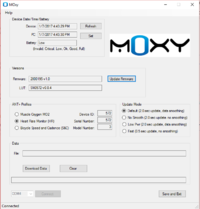Difference between revisions of "Moxy"
User:Fellrnr (User talk:Fellrnr | contribs) |
User:Fellrnr (User talk:Fellrnr | contribs) |
||
| (One intermediate revision by the same user not shown) | |||
| Line 1: | Line 1: | ||
{{DISPLAYTITLE:Moxy Muscle Oxygen Monitor Review}} | {{DISPLAYTITLE:Moxy Muscle Oxygen Monitor Review}} | ||
[[File:Moxy.jpg|right|thumb|150px]] | [[File:Moxy.jpg|right|thumb|150px]] | ||
| − | Moxy is a device for measuring [[Muscle Oxygen Saturation]] or SmO<sub>2</sub>. | + | Moxy is a device for measuring [[Muscle Oxygen Saturation]] or SmO<sub>2</sub>. Currently it is the only Muscle Oxygen sensor on the market after both [[Humon]] and [[BSX]] went out of business. |
=Introduction= | =Introduction= | ||
Moxy works by shining infrared light through the skin and into the muscle to measure how much oxygen your blood is carrying to that muscle, called [[Muscle Oxygen Saturation]] or SmO<sub>2</sub>. The idea is that a hard-working muscle will use a lot of oxygen so the blood in the muscle will have less oxygen remaining. Moxy provides a figure for the percentage of oxygenated blood compared with the overall total. (For the technically minded, Moxy is looking at the differential infrared absorption from saturated and desaturated hemoglobin.) This technique has been used in laboratories for a while, but Moxy is the first device that is practical for regular use. Moxy is a small device that is taped above the muscle, and provides real-time information to a variety of devices including many recent Garmin watches. In many ways Moxy is a similar to a heart rate monitor, measuring something that is a proxy for exercise intensity. The Moxy approach is a little different to many others because it measures a specific muscle, and while that is influenced by overall exercise intensity it does provide some uniquely muscle specific insights. The Moxy has the characteristics of a research device rather than a consumer product. It's rather expensive, and some aspects of it are a little crude, but the flip side is that a lot more effort has gone into the underlying functionality. It's not a trivial device to get the best out of, and I think it will appeal more to coaches and serious athletes than it will to the recreational runner. While [[Muscle Oxygen Saturation| SmO<sub>2</sub>]] sensors are compared to measuring blood Lactate, I don't think this is valid. | Moxy works by shining infrared light through the skin and into the muscle to measure how much oxygen your blood is carrying to that muscle, called [[Muscle Oxygen Saturation]] or SmO<sub>2</sub>. The idea is that a hard-working muscle will use a lot of oxygen so the blood in the muscle will have less oxygen remaining. Moxy provides a figure for the percentage of oxygenated blood compared with the overall total. (For the technically minded, Moxy is looking at the differential infrared absorption from saturated and desaturated hemoglobin.) This technique has been used in laboratories for a while, but Moxy is the first device that is practical for regular use. Moxy is a small device that is taped above the muscle, and provides real-time information to a variety of devices including many recent Garmin watches. In many ways Moxy is a similar to a heart rate monitor, measuring something that is a proxy for exercise intensity. The Moxy approach is a little different to many others because it measures a specific muscle, and while that is influenced by overall exercise intensity it does provide some uniquely muscle specific insights. The Moxy has the characteristics of a research device rather than a consumer product. It's rather expensive, and some aspects of it are a little crude, but the flip side is that a lot more effort has gone into the underlying functionality. It's not a trivial device to get the best out of, and I think it will appeal more to coaches and serious athletes than it will to the recreational runner. While [[Muscle Oxygen Saturation| SmO<sub>2</sub>]] sensors are compared to measuring blood Lactate, I don't think this is valid. | ||
Latest revision as of 02:28, 12 July 2023
Moxy is a device for measuring Muscle Oxygen Saturation or SmO2. Currently it is the only Muscle Oxygen sensor on the market after both Humon and BSX went out of business.
Contents
1 Introduction
Moxy works by shining infrared light through the skin and into the muscle to measure how much oxygen your blood is carrying to that muscle, called Muscle Oxygen Saturation or SmO2. The idea is that a hard-working muscle will use a lot of oxygen so the blood in the muscle will have less oxygen remaining. Moxy provides a figure for the percentage of oxygenated blood compared with the overall total. (For the technically minded, Moxy is looking at the differential infrared absorption from saturated and desaturated hemoglobin.) This technique has been used in laboratories for a while, but Moxy is the first device that is practical for regular use. Moxy is a small device that is taped above the muscle, and provides real-time information to a variety of devices including many recent Garmin watches. In many ways Moxy is a similar to a heart rate monitor, measuring something that is a proxy for exercise intensity. The Moxy approach is a little different to many others because it measures a specific muscle, and while that is influenced by overall exercise intensity it does provide some uniquely muscle specific insights. The Moxy has the characteristics of a research device rather than a consumer product. It's rather expensive, and some aspects of it are a little crude, but the flip side is that a lot more effort has gone into the underlying functionality. It's not a trivial device to get the best out of, and I think it will appeal more to coaches and serious athletes than it will to the recreational runner. While SmO2 sensors are compared to measuring blood Lactate, I don't think this is valid.
2 Moxy Placement
Where BSX has a nice calf compression sleeve that it slots into, Moxy requires taping onto your skin. This is far from ideal, but in practice is works well enough. Moxy provides some specific tape that has a hole cut out and a ring of adhesive on the outside to hold the Moxy in place. I've typically put the Moxy on my calf to mirror the positioning of the BSX so I can compare the two, but when I want to use the Moxy on its own I tape it over my quad. The company claims the Moxy will read the muscle through up to 12mm/0.5" of fat, which may be a factor in placing the Moxy for some athletes. The Moxy is fairly immune to movement as long as it's well attached, unlike Pulse Oximeters which won't tolerate even slight movement. (Pulse Oximeters measure superficial blood flow which includes venous and arterial blood flow, so they have to detect the pulsing arterial blood and ignore the deoxygenated venous flow. The Moxy is reading the blood far deeper so this is not an issue. It's also why Moxy won't tell you your heart rate.) Moxy should be waterproof enough for running or cycling in the rain, but they recommend putting it in a small sealed bag for use underwater. Ambient light can cause a problem for Moxy, and they sell a small plastic "Light Shield" that blocks the light. I didn't buy the light Shield and simply cover my Moxy with a piece of light proof fabric. While my approach works, I'd recommend getting the light Shield, as you need something you're confident will block infrared light and normal materials will be effective.
3 Charging and Battery life
The Moxy charges in about 90 minutes using a standard micro-USB cable and lasts for about 3 hours. Given that the Moxy will mostly be used for higher intensity training, the battery life is going to be adequate for most athletes. The Moxy has an LED that will blink a number of times when the power button is pressed to show you the battery life.
4 Configuration
5 Real Time Data
Unlike many other Running Sensors, Moxy does not have its own dedicated smartphone app. Instead, it transmits its data over Ant+, which makes it available to a vast array of running watches. You can set up the Moxy to pretend it's either a heart rate monitor or a Footpod, so even relatively old Garmin watches can display and record the data. With the newer Garmin watches that support Connect IQ you can display and record SmO2 data natively. The high-end Garmin watches from 2016 on will even support SmO2 without the need for a Connect IQ data field. (This includes the Garmin Fenix 5X, 630, & 735XT.) I much prefer this approach over the dedicated smartphone app that locks you in to a limited set of functions, and requires you to carry a heavy phone. If you are using Moxy on a treadmill you can connect it to rather more sophisticated software for real-time analysis. I used Golden Cheetah with an Ant+ USB stick quite successfully. Seeing the data on a laptop screen is far easier to read while you're running, and gives something to distract you from the suffering of an incremental stress test.
6 Post Run Analysis
Moxy continues this open, collaborative approach to post run analysis, making its data available in a standardized format and are working with various software makers to and in support for the Moxy SmO2 data. I've used SportTracks quite successfully, as well as Golden Cheetah, even though it's really focused on cycling rather than running. There's quite a few other software packages that support Moxy's SmO2 data.
7 Moxy, SmO2, and Lactate Threshold
There are a couple of generally used protocols to estimate Lactate Threshold using Moxy. I've not seen any scientific research that confirms the validity of using these protocols to estimate Lactate Threshold. This type of validation is not trivial, as most protocols for estimating Lactate Threshold from measurement of Blood Lactate are extremely flawed. Having read extensively the research available on Lactate Threshold I have a suspicion that SmO2data may actually be rather more useful for estimating an athlete's anaerobic threshold.
- Incremental Stress Test. A common approach for measuring Lactate Threshold using a finger prick based blood lactate test is the incremental stress test. The athlete starts off at a moderate pace, which is incremented every few minutes until the athlete can no longer continue. Because blood lactate levels take around 20 minutes to stabilize at a given intensity this is a flawed approach. It's unclear to me if using the same incremental stress test can be used based on SmO2 or not. It's possible that the SmO2value will respond far more rapidly than Blood Lactate, overcoming that weakness. Performing an incremental stress test with Moxy is a fairly straightforward, and the Lactate Threshold should match the intensity level where SmO2 values drop continuously rather than stabilize. The graph below is from the Moxy website, and shows how this should look.

- The 5-1-5 Test. This test is broadly similar to the incremental stress test, but rather than having just a few minutes (typically 2 or 3) at a given intensity the athlete exercise is for 5 minutes, followed by a 1 minute recovery period and another 5 minute bout. The athlete performs several of these 5-1-5 bouts at incrementing intensities. Below is another Moxy illustration showing the incrementing intensities and the SmO2 values.

8 Usefulness of Moxy
There is a lot of interest in measuring Lactate Threshold in athletes. This is partly because Lactate Threshold has shown to be a predictor of race performance, but measuring lactate threshold is problematic at best. A second driver for measuring Lactate Threshold is the belief that training at the intensity that matches an athlete's Lactate Threshold is particularly valuable, a type of training often called Tempo Runs. Unfortunately, the available scientific research indicates that this is actually a particularly ineffective training intensity. Another use is to measure of the effectiveness of an athlete High Intensity Interval Training (HIIT). There is a great deal of research that shows that HIIT is an extremely potent form of training, and the Moxy can be used to evaluate if an athlete is working hard enough to drive down there SmO2. However, the readings vary with placement and with other factors, so after years of using Moxy during HIIT, I've not found any useful insight.
9 Is Moxy Accurate?
Without laboratory grade equipment that researchers use to study SmO2 I have no way of independently validating the accuracy of Moxy. However, I did do some crude validation of Moxy as part of my testing of BSX. When performing an incremental stress test, research shows that the SmO2 value should arise from its resting level quite rapidly then decline as intensity increases. In my testing, Moxy consistently exhibited this behavior, while BSX never showed any correlation between exercise intensity and its value of SmO2.
10 Total Hemoglobin (tHb)
Moxy can also estimate the relative blood flow to a muscle, referred to as Total Hemoglobin or tHb. This is only a relative measure, but it does give some insight to how the muscle is being activated.




